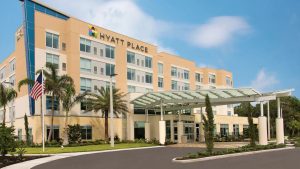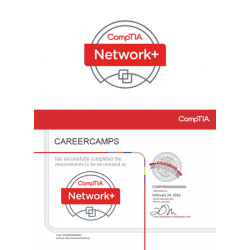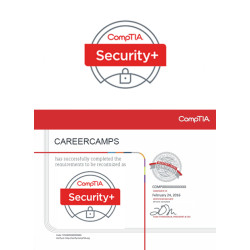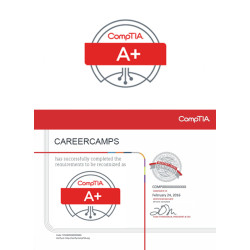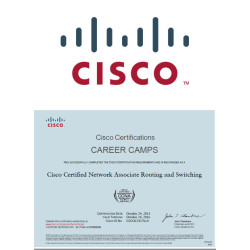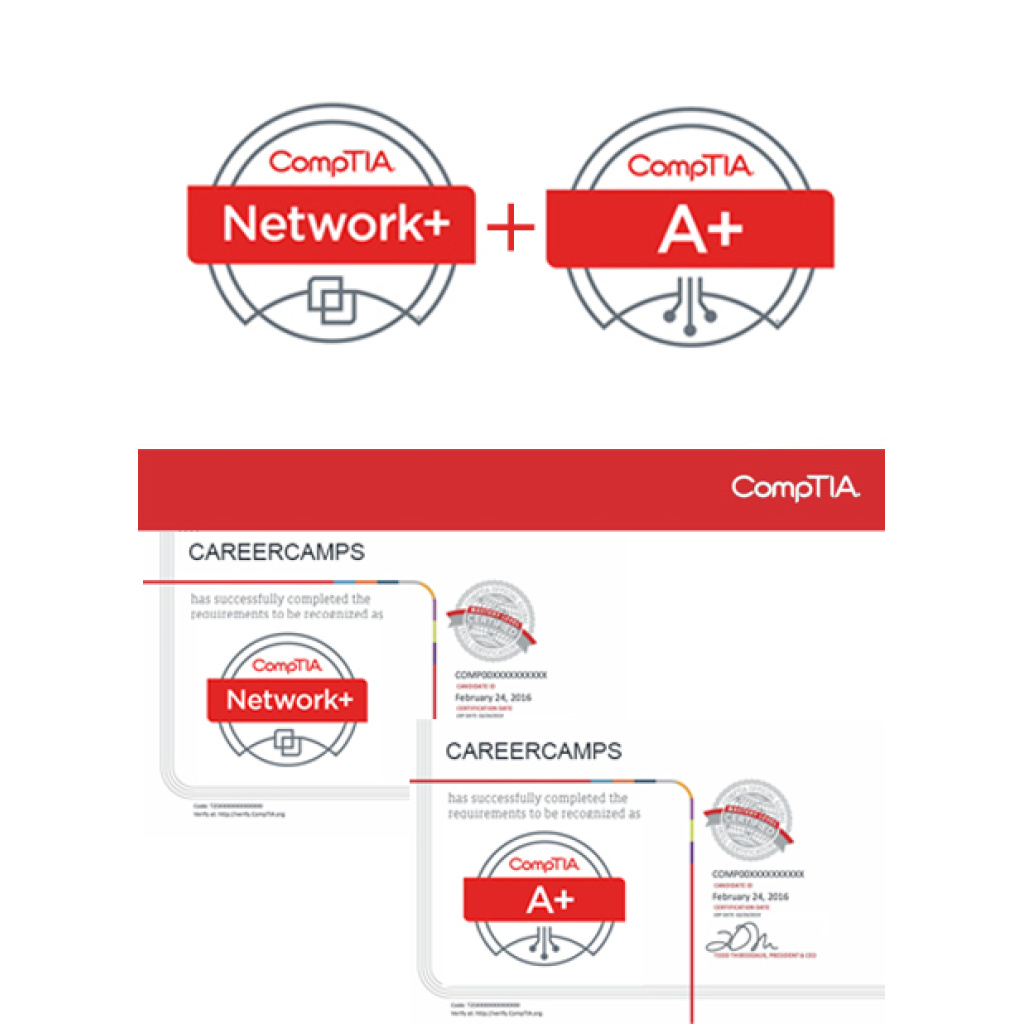
CompTIA A+/Network+ Certification Camp
$2,995.00
Our CompTIA A+ and Network+ Dual Certification Bootcamp is expertly designed to provide a comprehensive IT foundation through one intensive training program. You’ll gain in-depth knowledge of hardware troubleshooting and core networking concepts while preparing for two of the industry’s most sought-after certifications.
We also offer these camps individually – CompTIA Network + Certification Camp and CompTIA A+ Certification Camp.
EXAMS INCLUDED
220-1201: CompTIA A+
220-1202: CompTIA A+
N10-009: CompTIA Network+
WHAT IS INCLUDED
| Exam Pass Guarantee | |
| Exam Review Guide | |
| Exam Review Sessions | |
| CompTIA Training Courseware | |
| 3 CompTIA Exam Vouchers | |
| Practice Test Questions | |
| Exam Delivery Support | |
| CPE/CEU Post Class Package |
LOCATIONS
Career Camps offers this camp onsite in many locations around the US and we also offer it as an online live as a virtual class. Some of the locations include Philadelphia, Los Angeles, Washington Las Vegas, and San Diego. This camp is also offered in different time zones. Please contact us to get the onsite schedule or simply check the dates and locations in the class dates selection below.
Description
CompTIA’s A+/Network+ combo certification camp requires 3 exams to achieve 2 certifications in this 7 day camp. Our A+/Network+ Boot Camp represents the culmination of hundreds of hours of instructional design, thousands of hours of exam-focused instruction, and tens of thousands of efficiently and effectively skilled, certified students.
The A+/Network+ boot camp incorporates CompTIA Official Courses –
CompTIA A+ 220-1201
CompTIA A+ 220-1202
CompTIA Network+ N10-009
Skills Gained:
Install and configure PC system unit components and peripheral devices.
Install, configure, and troubleshoot display and multimedia devices.
Install, configure, and troubleshoot storage devices.
Install, configure, and troubleshoot internal system components.
Explain network infrastructure concepts.
Configure and troubleshoot network connections.
Implement client virtualization.
Support and troubleshoot laptops.
Support and troubleshoot mobile devices.
Support and troubleshoot print devices.
Support operating systems.
Install, configure, and maintain operating systems.
Maintain and troubleshoot Microsoft Windows.
Configure and troubleshoot network connections.
Manage users, workstations, and shared resources.
Implement physical security.
Secure workstations and data.
Troubleshoot workstation security issues.
Support and troubleshoot mobile operating systems and applications.
Implement operational procedures.
Describe the features of different network protocols and products for LANs, WANs, and wireless networks
Understand the functions and features of TCP/IP addressing and protocols
Identify threats to network security and appropriate countermeasures and controls
Install and configure network cabling and appliances
Manage, monitor, and troubleshoot networks
Topics Covered in this Official Boot Camp:
Before Class
Starting your CompTIA journey with thorough preparation significantly enhances your learning experience and sets you up for success. Engaging with our pre-course materials and connecting with expert instructors before the class allows you to familiarize yourself with key concepts, identify areas for improvement, and arrive ready to fully immerse yourself in the intensive training.
Day 1 – Introduction to CompTIA A+ & Hardware Fundamentals
Morning
Course & Exam Overview: Introduction to course objectives, exam structure, and certification benefits.
IT & Hardware Essentials: Overview of computer components; understanding motherboards, CPUs, RAM, storage devices, and power supplies.
Afternoon
Peripheral Devices & Connectivity: Overview of cables, connectors, and peripheral devices.
Hands‑On Lab: Identifying and assembling key hardware components.
Q&A & Recap
Day 2 – Operating Systems & Software Management
Morning
Operating Systems Overview: Introduction to Windows, macOS, and Linux environments.
Installation & Configuration: Best practices for installing and configuring operating systems.
Afternoon
Software & System Troubleshooting: Techniques to diagnose and resolve software issues.
Virtualization & Cloud Basics: Introduction to virtualization concepts and cloud computing fundamentals.
Hands‑On Lab: OS installation and basic troubleshooting exercises.
Interactive Q&A
Day 3 – Mobile Devices, Basic Networking & Security Fundamentals
Morning
Mobile Device Management: Configuring, synchronizing, and troubleshooting mobile devices.
Introduction to Networking (A+ Focus): Overview of networking basics including cables, ports, and protocols.
Afternoon
Security Essentials: Fundamental security practices, authentication methods, and malware protection strategies.
Hands‑On Lab: Mobile device configuration and testing basic network connectivity.
Review & Q&A
Day 4 – Advanced Troubleshooting & A+ Exam Preparation
Morning
Advanced Troubleshooting Techniques: In‑depth approaches for diagnosing hardware and software
Operational Procedures: Emphasizing best practices, safety protocols, and documentation.
Afternoon
Maintenance & Optimization: Strategies for system upkeep and performance improvement.
Exam Preparation Workshop: Review of key A+ concepts, practice questions, and exam‑taking strategies.
Final Q&A Session for A+ Module
Day 5 – Introduction to CompTIA Network+ & Networking Fundamentals
Morning
Network+ Overview: Introduction to exam objectives, networking terminology, and course layout for the Network+ module.
Networking Models: Detailed look at the OSI and TCP/IP models.
Physical Layer Essentials: Exploring cabling, network topologies, and hardware components (routers, switches, hubs).
Afternoon
IP Addressing & Subnetting: Fundamental concepts in IP addressing, subnet masks, and basic network configuration.
Hands‑On Lab: Setting up a basic network environment.
Interactive Q&A
Day 6 – Advanced Networking Protocols & Network Security
Morning
Networking Protocols: Deep dive into DNS, DHCP, NAT, VPN, and wireless standards.
Routing & Switching Basics: Understanding core concepts for network traffic management.
Afternoon
Network Security Fundamentals: Overview of firewalls, encryption methods, and threat mitigation.
Hands‑On Lab: Configuring routers/switches and troubleshooting connectivity issues.
Review & Q&A
Day 7 – Network Management, Troubleshooting & Network+ Exam Strategies
Morning
Network Management & Monitoring: Tools and techniques for network performance assessment and monitoring.
Advanced Troubleshooting: Practical approaches to diagnose and resolve complex network issues.
Afternoon
Wireless Networking & Remote Access: Best practices for securing and managing wireless networks and remote connections.
Final Exam Prep: Consolidated review, practice questions, and exam strategies tailored for the Network+ exam.
Final Q&A, Wrap‑Up & Next Steps
Additional information
| Class Dates | 10/20/2025 – 10/26/2025 – Dallas, TX, 10/20/2025 – 10/26/2025 – Virtual 9am EST Start, 11/03/2025 – 11/09/2025 – Atlanta, GA, 11/03/2025 – 11/09/2025 – Virtual 9am EST Start, 12/01/2025 – 12/07/2025 – Philadelphia, PA, 12/01/2025 – 12/07/2025 – Virtual 9am EST Start, 01/26/2025 – 02/01/2025 – Dallas, TX, 01/26/2025 – 02/01/2025 – Virtual 9am EST Start, 02/16/2025 – 02/22/2025 – Philadelphia, PA, 02/16/2025 – 02/22/2025 – Virtual 9am EST Start, 03/30/2026 – 04/05/2026 – Denver, CO, 03/30/2026 – 04/05/2026 – Virtual 8am PST Start |
|---|
Our Facilities
CAREER CAMPS FACILITIES
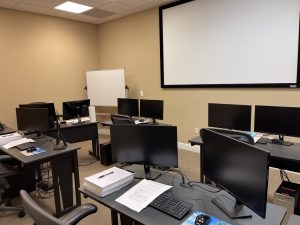
CLASSROOM EQUIPMENT – Students work on a dedicated Dell Client Desktop with 32GB memory with 512GB SSD drives – All Labs are executed the extremely fast Microsoft Data Center Hosted Lab Environment.
CAMPUS INTERNET – The campus is connected with a 1Gbps (1,000 Mbps) Verizon Fios Business Connection which provides complete internet (including VPN) access for students.
COMMON AREA – Amenities including snacks, drinks (Coffee, 100% juices, sodas, etc) all complimentary.
LODGING – We use the Hyatt Place Lakewood Ranch. This “upgraded” hotel offers extremely comfortable beds, great breakfast and very fast internet access.
NEAR BY AMENITIES – Many shops, restaurants and grocery options are available within walking distance. Additionally – the hotel provided scheduled shuttle services. Restaurants like Bone Fish Grill, Ruby Tuesday’s, Five Guys, Chipotle, Quiznos, Chili’s and over 20 additional choices in the immediate area. All of these options are offered in a pedestrian walking village.
Why Choose Us
CAREER CAMPS DIFFERENCE
Career Camps provides an in-depth hands on learning environment. Our instructors teach using demonstrations and explain concepts beyond the scope of the courseware. The best instructors are contracted from all across the US. These professionals are real world consultants who actually implement these technologies. Career Camps knows our clients work in the “real world” and it only makes sense to have an instructor with the experience in the real world.
Facilities – Many of our competitors over-crowd classrooms by placing 2 to 3 students per desk and 20+ students per instructor. Often these companies “extend” the life of very old equipment with slow performance on the software used today. Our average class size is 8 students. Our facilities have the best equipment with the most comfortable, focused environment for learning.
Instructors – Our CEO, Chester Flake holds one of the rarest Microsoft Certifications – the Microsoft Certified Learning Consultant (MCLC) Certification. This certification reflects a commitment to make sure our instructors are also actively engaged in real world consulting projects. Students expect a professional who can answer questions and demonstrate the technology.
Face to Face Training – We believe the best way to interact and learn is face to face training. Many of our competitors which offer local training are simply providing students with headphones/mic to attend class with an instructor at a remote location.
Test Pass – We offer a free retake voucher (if needed) for each of the exams required for certification. Any training center offering a “100% pass guarantee” would have to use unethical practices or unlimited test vouchers (which is not likely or practical).
Distractions – Students often look for a “local” training center so they can be close to home and work. Boot camp requires a tremendous time commitment during the program. Long class hours combined with self study each evening. The goal of boot camp is to achieve certification in a fraction of the time. We strongly recommend students attend camp away from home and work in a focused, distraction free environment.
Boot Camp – Boot camp is an accelerated training focused on teaching technology and testing students on the official exams. Most training providers “added” boot camps to the existing standard training classes they offer. These training centers think a boot camp is just a regular class where you send the student home with a voucher on the last day. Career Camps administers exams throughout the camp. Equally important – not every trainer can teach a boot camp and not all courseware is designed for boot camp format. Our trainers know the boot camp format and our courseware is designed for accelerated learning.
Florida – Career Camps has one of the most scenic locations boasting some of the best weather in US. We believe students should have a comfortable and inviting atmosphere while attending these otherwise intense programs. We place our location, facilities and amenities up against that any competitor.
CompTIA Program
We are often asked… “How can you achieve certification with just a few days of training?” Career Camps Boot Camps is an accelerated learning environment. We take the CompTIA Training Materials – remove the unnecessary content and focus on the topics specific to certification. Our instructors use hands on demonstrations to bring test objectives to life. Students are completely immersed in the technology.
Training Provided
We use CompTia Courseware covering information specific to the exams. Our instructors hold all relevant CompTia Certifications.
You May Also Like:
Related products
-
CompTIA Network+ Certification Camp
$2,995.00 Select options This product has multiple variants. The options may be chosen on the product page -
CompTIA Security+ Certification Camp
$2,895.00 Select options This product has multiple variants. The options may be chosen on the product page -
CompTIA A+ Certification Camp
$2,495.00 Select options This product has multiple variants. The options may be chosen on the product page -
Cisco CCNA Certification Camp
$3,495.00 – $4,195.00Price range: $3,495.00 through $4,195.00 Select options This product has multiple variants. The options may be chosen on the product page
